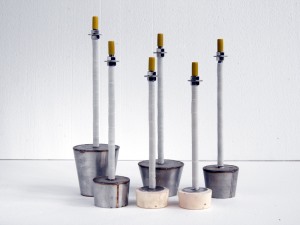Analysis of Characteristics of Refined Ladle Dispersion Type Breathable Bricks
Due to the special structure of the dispersion block, the dispersion-type air-permeable brick avoids the problem of the slit steel of the slit-type air-permeable brick, and can ensure the air permeability; at the same time, the bubbles are small, many and uniform, and the bottom blowing and stirring effect is good. It is because of these properties , so that the dispersion type ventilation brick has been widely used. Today, Xiaobian will give you a detailed introduction to the performance of a new type of dispersion type ventilation brick for refining ladle.
1, the internal structure
Dispersion type ventilation bricks need to make the bottom round table and dispersion block first, and then form the brick core like ordinary slit type ventilation bricks, and the production process is more complicated.
2, physical and chemical indicators
In order to ensure the long life of the dispersion block, the dispersion type breathable brick adopts synthetic raw materials with high strength, high refractoriness and excellent corrosion resistance, and adopts a combination structure of a breathable inner core and dense high-strength materials.
3, Microstructure
The microstructure of the breathable inner core and the simulated phenomenon of blowing water are shown in Figure 2:
Because of its microstructure characteristics, the new type of diffused permeable brick will not cause the bottom blowing impermeability or bad phenomenon caused by the slit steel that often occurs in the original slit type permeable brick. The flow in the slit produces a large temperature gradient, and the local thermal stress is concentrated near the slit, especially at the gas outlet of the slit, which causes the size of the slit to change during use, resulting in the molten steel easily entering the slit. In the middle, it will cause the bottom blowing impermeability or bad phenomenon. In addition, if the bottom blowing valve is quickly closed at the end of refining, the molten steel will enter the slit with positive pressure, so it is necessary to install a reverse osmosis one-way stop valve on the argon blowing pipeline. Therefore, the slit type ventilation Bricks must have suitable and stable slit airway size and raw materials with good thermal stability to reduce slit steel. The ventilation channels of diffused ventilation bricks are a large number of connected pores dispersed inside the brick body (as shown in Figure 2). ), these micron-scale curved channels cause a large resistance to the penetration of molten steel, which is basically non-permeable in actual use. As shown in Figure 3, the air bubbles generated by the diffused permeable brick are small, uniform and dense, making it easier to Stir the molten steel to a uniform temperature, it is easier to cause the inclusions to float up and achieve a better refining effect.
4, thermal stability
The new type of diffused permeable brick is not easy to cross the surface of the brick core. When the ordinary slit type permeable brick is blown with argon, the outlet of the slit is in direct contact with the high-temperature molten steel and the cold air flows out continuously, resulting in a large temperature gradient, resulting in slits The thermal stress at the air outlet is particularly large, coupled with the rapid cooling and rapid heating during use, it is easy to cross the air outlet near the slit, causing the slit to shift and the bottom to blow through. Thermal stress can easily cause the cross-section of the slit-type permeable brick, which puts forward relatively high requirements for the thermal shock resistance of the refractory material. However, there are micron-scale gas channels on the entire working surface of the diffused permeable brick, and the working surface temperature The gradient is small, so the new type of diffused breathable brick is not easy to cross the surface of the brick core.
5, safety display
The shape of the product, the safety display of the breathable brick is a slit design. In this design, the phenomenon of slits in the later period of use is more obvious and easy to observe. When the slits are exposed, the ladle can be immediately considered offline, and the safety is high. It is not required during continuous use. Oxygen burning maintenance can reduce the labor intensity of hot repair workers and the consumption of oxygen and oxygen pipes.

Related News
- Introduction of construction method of ramming material in intermediate frequency furnace
- How to choose the material of furnace lining
- The difference between rammer and castable
- Application direction of intermediate frequency furnace refining
- Introduction to the construction method of dry ramming material
- Do you know the production process and control points of breathable bricks?
- The application of argon blowing technology at the bottom of the intermediate frequency furnace
- Method for prolonging service life of intermediate frequency furnace lining
- In addition to diffused breathable bricks, there are those types of breathable bricks
- What are the advantages of coil cement
- Specific analysis of the ventilation performance of the ventilation brick
- Factors Affecting the Effect of Argon Blowing Bricks at the Bottom of Ladle
- Composition and properties of ramming materials for glass kilns
- Phenomenon analysis of failure of argon blowing of ladle permeable bricks and how to improve the rate of argon blowing
- How to Reduce Inclusions in Steel in Medium Frequency Induction Furnace Smelting
- What are the control points of nickel and cobalt elements in the smelting of medium frequency induction furnace?
- What are the requirements for the production materials of breathable bricks?
- How is the neutral ramming material of the intermediate frequency furnace made?
- Intermediate frequency charge manufacturer: design characteristics of coil cement
- Taking breathable bricks as an example, the basic knowledge of refractory materials is briefly described


